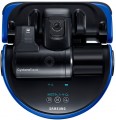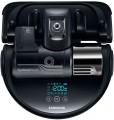Power adjustment
The type of power regulator provided in the design of the vacuum cleaner.
By itself
, power adjustment allows you to adjust the operating mode to the current situation. For example, to clean a thick carpet, it is better to use a vacuum cleaner on full power, and on a delicate sofa or chair, it may be better to reduce the power. Types of power regulators are distinguished by location; options can be as follows:
— On body. The most popular option among modern vacuum cleaners. The main advantage of models with this design is that they do not require special hoses (unlike the units described below with adjustments on the handle). However, installation on the body is not very convenient for conventional vacuum cleaners (see "Type") — to change the power, you have to lean towards the body every time. However, for most users, it is not critical.
— On handle.
The power regulator on the handle of the vacuum hose is convenient because the control is right at your fingertips, and you can change the power with just one movement of your finger, without bending over to the body. However, this convenience has a downside. So, some of these vacuum cleaners can only be fully used with special hoses; when installing a classic hose (without a regulator), the device, at best, will only work at full power, without adjustment, at worst, it will not turn on at all. A special hose is usually included
...in the kit, but finding a replacement for it can be a quite troublesome (and costly) business. In other models, a wireless remote control is used, and its presence significantly affects the price of the unit.
— On body and handle. Vacuum cleaners combine both of the options described above. Usually, a hose with a regulator on the handle is supplied with such a unit. However, if necessary, you can install a regular hose and change the power with a switch on the body. Such control is the most versatile. Nevertheless, it is more expensive than each of the options described above.Fine filter
The presence of a
HEPA fine filter in the vacuum cleaner; also in this paragraph, the specific class of this filter is often specified.
HEPA (High Efficiency Particulate Absorbing) filters are designed to purify the air from the smallest mechanical contaminants — up to tenths of a micron in size. It allows you to trap not only fine dust but even bacteria. For comparison: the size of most bacteria starts at 0.5 microns, and the effectiveness of HEPA filters is evaluated by the ability to retain particles with a size of 0.1 – 0.3 microns. The most advanced such filters (
class 13 and above) are able to remove more than 99.9% of these particles from the air. Here is a more detailed description of the different classes:
— HEPA 10 – traps at least 85% of particles with a size of 0.1 – 0.3 microns;
— HEPA 11 – at least 95% of such particles;
— HEPA 12 – not less than 99.5%;
— HEPA 13 – not less than 99.95%;
— HEPA 14 – not less than 99.995%;
Note that pollution with a size of 0.1 – 0.3 microns is the worst-kept by HEPA filters, so with particles of other sizes (both larger and smaller), the efficiency of such elements will be even higher.
Regarding the choice for this parameter, it is worth noting that, in fact, it does not always make sense to pursue a high filtration class. For example, during wet cleaning with a washing vacuum cleaner (see abov
...e), the HEPA filter, in fact, is not needed at all (in many models, it is recommended to remove it altogether for such cases). So if you plan to use such a vacuum cleaner mainly for washing, you can ignore this parameter. Another specific case is industrial units (see "Type"): they are often used for rough cleaning of large debris, where thorough air filtration is not required.Cleaning area limit
A method for limiting the processed space provided in a robot vacuum cleaner.
Another name for this feature is
"virtual wall". Its general meaning is quite obvious: a “wall” (or several walls) allows you to limit the movement of the robot on the surface to be cleaned. It can be useful if cleaning needs to be done in a room without a door. Or if part of the floor is occupied by small items that do not need to be cleaned (for example, pieces of a puzzle being assembled). But the specific possibilities of such a restriction are directly related to how it is implemented. Note that the function is found mainly in middle-class robot vacuum cleaners and top models. Budget robotic "cleaners" often do not have the function of limiting the zones of the processed space - they do not have one.
Here are the main options found in modern robots:
— Laser sensor. A fairly popular option due to its simplicity, low cost, as well as simplicity and ease of use in fact. Usually, when installing the laser limiter, it is enough to put it on the floor and point it in the right direction. On the other hand, such devices are not well suited for creating complex borders. The classic format of the laser limiter is linear: a doorway or room is blocked by a direct beam, which is perceived by the robot as the boundary of the treated area. In addition, some models may also provide a circular mode, when the sensor forms a "forbidden zone" in
...the form of a circle or sector of a certain diameter. This format of work allows to fence off the corners of rooms and small areas near the walls (a typical example is the location of a dog or cat bowl in the kitchen). If you need to create a border of a different, more specific shape, this will require several sensors at best (even though one limiter is usually supplied in the kit if supplied at all); and in the worst case, it will be completely impossible. It is also worth considering that the range of the laser in linear mode is usually limited to 3 – 4 metres; this is most often sufficient for residential premises and small offices. However, it may not be enough for a large space. And the emitters are usually powered by batteries or accumulators, the charge of which is limited.
— Magnetic tape. Limiter in the form of a tape made of magnetic material laid on the floor. Such a tape is spotted by a special sensor and is perceived by the robot as a border that cannot be crossed. For secure fixation, it is usually made self-adhesive, and the intensity of the magnetic field in most cases ensures effective operation through carpets and other similar coverings. One of the key advantages of such restraints is that almost any shape of the restricted zone can be formed from the sections of tape: the length of individual sections can be chosen at your discretion, and the maximum total length is limited only by the stock of tape at hand. In addition, this type of limiter does not require power. The disadvantages of this option include the complexity of laying in some conditions (for example, under a continuous carpet covering). In addition, at best, a very small amount of tape is included in the package; and many vacuum cleaners are not equipped with it at all, so you need to buy a magnetic tape additionally.
— Via the application. The most advanced way to limit cleaning: the boundaries of the working area are set on a smartphone or other gadget through an application that is also used for general control of the robot. Almost all models with this function also have the function of building a map of the premises (see below) — the finished map is displayed in the application, and on it the user can set the boundaries of the working area at will. The simplest version of such borders is separate straight lines. However, control applications often provide more extensive features: broken lines and polygons from individual segments, standard shapes (circle, oval, rectangle) and even the ability to draw a border by hand. Anyway, this method of restriction is extremely convenient and functional. However, robot vacuum cleaners with this capability are expensive, mainly due to the presence of a complex mapping system.Battery run time
The operating time of a battery-powered vacuum cleaner (see "Power supply") on a single battery charge.
Usually, the average operating time in normal mode is indicated here. Accordingly, in fact, the battery life of the vacuum cleaner may differ slightly from the claimed one, depending on the chosen application format. Nevertheless, the operating time indicated in the specifications is a fairly reliable indicator; it can be used both for a general assessment of battery life and for comparing the selected vacuum cleaner with other models.
Separately, we note that increasing battery life requires either the use of more capacious (and therefore more expensive and heavier) batteries or a decrease in engine power (and the efficiency of the unit as a whole). So it is worth looking specifically for a long working vacuum cleaner if these moments are outweighed by a long operating time.
Noise level
The noise level produced by the vacuum cleaner during operation. Usually, the value for normal operation at maximum engine power is indicated here. With less power, the loudness of the unit may be lower, but the key is precisely the maximum indicator.
Regarding specific numbers, keep in mind that the decibel used to measure the noise level is a non-linear quantity. Therefore, it is worth evaluating specific indicators using special comparative tables. In general, vacuum cleaners are quite noisy appliances; so in this case, models are considered quiet if this indicator
does not exceed 65 dB — this is the level of a loud conversation between 2 – 3 people at a distance of 1 m. The quietest of these models give out only 40 dB — this is the average volume of a person’s speech in normal tones (and the minimum volume allowed for constant noise sources in living quarters during the day). For louder units, the comparison table looks like this:
—
66 – 70 dB — loud conversations between several groups of people at a distance of about 1 m;
—
71 – 75 dB — the volume of a cry or laughter in full voice at a distance of about 1 m;
—
76 – 80 dB — the volume of a mechanical alarm clock or the engine of an old truck;
—
more than 80 dB — a very high noise level, exceeding the level of a loud scr
...eam; when working with a vacuum cleaner having such specifications for a long time, it is highly desirable to use hearing protection.
Also note that the noise level largely depends on the engine power, as well as some other features (for example, it is strongly affected by the presence of an aquafilter — see "Dust collector"). At the same time, there is no hard connection here, and units with a similar set of specifications can differ markedly in actual loudness. In such cases, when choosing here, it is worth proceeding from the fact that a quieter vacuum cleaner will be more comfortable to use. However, it will most likely cost noticeably more.Display
The presence of its own
display in the design of the vacuum cleaner.
Most often, rather simple monochrome screens are used as built-in displays. However, even such screens significantly increase usability. They can display quite a variety of information about the operation of the unit: power level, involved programmes and special functions, the fullness of the dust collector, battery charge (with battery power), current time, error messages, and schedule settings for robots, etc.
Samsung POWERbot VR-20K9350WK often compared

